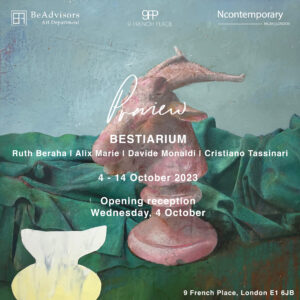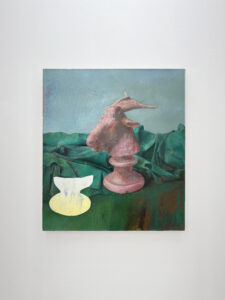Bestiarium
Ruth Beraha | Alix Marie | Davide Monaldi | Cristiano Tassinari
4 – 14 October 2023
Opening Wednesday, 4 October
Open from 4th until 15th October
from Tuesday to Sunday, 2 – 6 pm
Opening Hours: 14.00 – 18.00 – Closed Monday
Special opening hours – Frieze East End VIP Day (Sunday 8 October): 12.00 – 18.00
Special morning openings – Frieze week (12-14 October): 9.00 – 12.0
_______
9 French Place,
E1 6JB London

From the end of the 12th century to the first half of the 14th century in Europe, especially in England and France, a particular type of literary work spread, in some cases richly illustrated, in which animals were catalogued and described in their specific characteristics. The bestiaries had a rapid success and became essential elements in the libraries of monasteries, high prelates and nobles; they contained descriptions of deer, lions, bears, panthers but also of dragons and flying-fish (described in the Aberdeen Bestiary of the 12th century as a marine creature with a scaly body but provided with the beak, legs and wings of a bird). Whether they were real beings or fantastic animals, the authors of these unique works were not so much interested in giving a rigorous description from a zoological point of view, as in describing their character and moral peculiarities. In fact, the bestiary is poised between a scientific text, a religious work and a moralizing fable; qualities and vices were indicated of each beast, becoming an allegory of good and evil.
Today the world is no longer allegorical as it was in the Middle Ages, but animals and beasts maintain a strong symbolic charge. In the works of Ruth Beraha (Italy, 1986), Alix Marie (France, 1989), Davide Monaldi (Italy, 1983) and Cristiano Tassinari (Italy, 1980) the presence of bestial figures has been recurring for many years, with the aim of using animal figures as a tool to deepen the artists’ research on the topic of social power, memory, stereotypes and irony.
For Ruth Beraha the use of faunas’ images has been linked with the continuous research on individuals’ identity as well as power in contemporary society. In the series of works titled In the Beginning, for example, Beraha presents with the use of the stained glass technique several zoomorphic figures with a clear relation to polytheistic spirituality. In these works the animals are reminiscent of the artist’s Egyptian ancestry, a personal link with a country and history interrupted drastically in the ‘50s by Nasser’s expulsion of most Jews.
The link between images of animals and the political power is also visible in the artist’s series titled Goodfellas. In these works Chinese President Xi Jinping is portrayed gently moving his hand towards an elephant, while Bolsonaro poses next to a flamingo; the human presence is barely hinted at, the figures are in shadow, unrecognizable. The animals are the real protagonists of these propaganda images, used to create an allegorical connection between tenderness and bestiality, power and political consensus.
The body and the skin has long been at the centre of Alix Marie’s interest. In the artist’s research human and mythological elements intertwine continuously, with the aim to question feminine and masculine archetypes. Alix Marie often included animal elements in her artworks, cancelling the division between the human and the bestial sphere. In Escargot, an early production of the artist, the animal crawls on what looks like human skin; the movement of the snail appears to be in contrast with the deadly stillness of the skin.
Davide Monaldi’s ceramic sculptures are also filled with animalesque figures, often represented by the artist with humanised attributes or postures. Monaldi’s art pieces seem to be suspended between artisanal craftmanship and conceptual research, pop dream-like images and alternative views of reality. In his artworks the artist uses animals as part of his overall research on melancholy and irony: ants become central elements in classical ceramic vase compositions, birds take the human shape, as if evoking a self-portrait of the artist himself.
A contemporary miniaturist of imaginary bestiaries is also Cristiano Tassinari who has used extensively animal figures in his latest paintings. In his paintings violence and tenderness are often coexisting and the use of animal subjects extends further this feeling. Birds and goats become symbols to explore family relationship with his father and mother, as well as the broader representation of masculinity and femininity in art and society.

